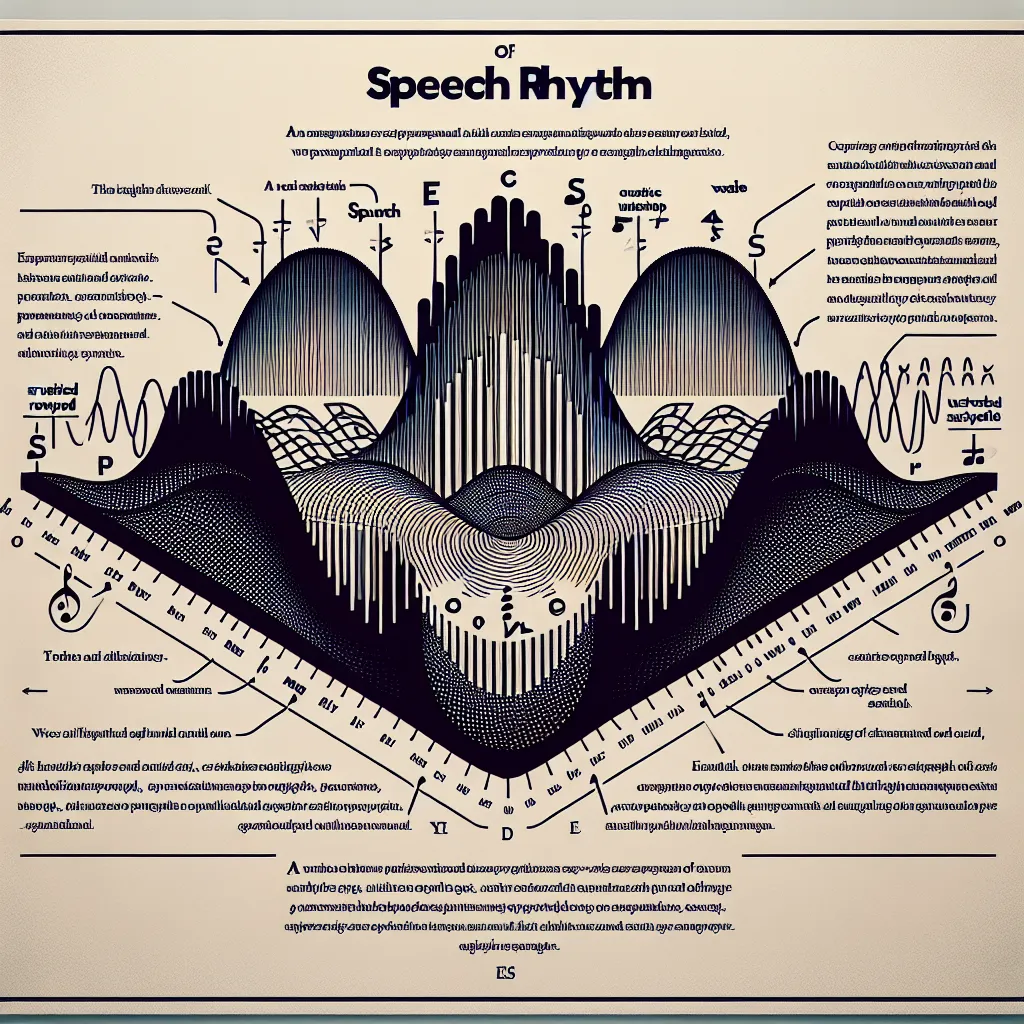Have you ever wondered why some people speak English with a natural, flowing rhythm while others sound choppy and robotic? The secret lies in mastering the rhythm of English speech. This guide will provide you with essential tips and techniques to improve your English rhythm and sound more like a native speaker.
Understanding the Importance of English Speech Rhythm
English speech rhythm is the pattern of stressed and unstressed syllables in spoken language. It’s a crucial aspect of pronunciation that can significantly impact your ability to communicate effectively in English.
 English Speech Rhythm
English Speech Rhythm
What is English Speech Rhythm?
English speech rhythm refers to the natural rise and fall of stress and intonation in spoken English. It’s characterized by:
- Stressed syllables: These are pronounced louder, longer, and with a higher pitch.
- Unstressed syllables: These are shorter, quieter, and often have a reduced vowel sound.
Understanding and mastering this rhythm is essential for several reasons:
- Improved comprehension: Native speakers rely on rhythm to process speech quickly.
- Enhanced fluency: A good rhythm makes your speech sound more natural and fluid.
- Better communication: Proper rhythm helps convey meaning and emotion effectively.
Key Components of English Speech Rhythm
To master the rhythm of English speech, you need to understand its core components:
1. Word Stress
In English, certain syllables within words are stressed more than others. For example:
- PHO-to-graph (stress on the first syllable)
- pho-TO-gra-pher (stress on the second syllable)
- pho-to-GRA-phic (stress on the third syllable)
Learning to identify and produce these stress patterns is crucial for developing natural rhythm.
2. Sentence Stress
In English sentences, content words (nouns, verbs, adjectives, and adverbs) are typically stressed, while function words (articles, prepositions, and pronouns) are usually unstressed. For example:
“The CAT is on the MAT.”
Here, “cat” and “mat” are stressed, while “the,” “is,” and “on” are unstressed.
3. Intonation
Intonation is the rise and fall of pitch in speech. It helps convey meaning, emotion, and attitude. For instance:
- Rising intonation: Often used for yes/no questions.
“Are you READY?” (pitch rises on “ready”) - Falling intonation: Typically used for statements and wh-questions.
“It’s TIME to go.” (pitch falls on “time”)
4. Connected Speech
In natural English speech, words often blend together. This includes:
- Linking: Connecting the final sound of one word to the initial sound of the next.
“Turn_it_on” sounds like “tur-ni-ton” - Elision: Omitting sounds.
“Next please” becomes “Nex please” - Assimilation: Changing sounds to make them easier to pronounce together.
“Good boy” sounds more like “goob boy”
Techniques to Improve Your English Speech Rhythm
Now that we understand the components, let’s explore techniques to enhance your rhythm:
1. Listen and Imitate
One of the most effective ways to improve your rhythm is through active listening and imitation. Try these exercises:
- Listen to native speakers in various contexts (news broadcasts, podcasts, movies).
- Pay attention to their stress patterns and intonation.
- Record yourself imitating short phrases or sentences, then compare with the original.
2. Practice with Music and Poetry
Music and poetry are excellent tools for developing rhythm:
- Learn and sing English songs, focusing on matching the rhythm and stress patterns.
- Read poetry aloud, emphasizing the natural rhythm of the verses.
- Try jazz chants, which are designed to teach English rhythm and intonation.
 English Rhythm Practice
English Rhythm Practice
3. Use Stress and Intonation Marks
When learning new vocabulary or phrases, mark the stress and intonation:
- Underline stressed syllables in words.
- Use arrows to indicate rising or falling intonation in sentences.
- Practice reading aloud with these visual cues.
4. Focus on Thought Groups
Native speakers naturally divide their speech into thought groups or chunks. Practice speaking in these chunks to improve your rhythm:
“I went to the store (pause) to buy some milk (pause) but they were closed.”
5. Use a Metronome or Rhythm App
A metronome can help you maintain a steady rhythm while speaking:
- Set the metronome to a slow pace (60-80 beats per minute).
- Practice speaking sentences in time with the beats, placing stressed syllables on the beats.
There are also apps designed specifically for English rhythm practice, such as “English Rhythm Trainer” or “Speech Trainer 3D.”
Common Pitfalls in English Speech Rhythm
Be aware of these common mistakes to avoid them in your own speech:
- Stressing every word equally: This leads to a robotic, unnatural rhythm.
- Ignoring sentence stress: Failing to emphasize content words can make your speech hard to understand.
- Using incorrect intonation patterns: This can lead to misunderstandings or unintended meanings.
- Neglecting connected speech: Speaking each word separately makes your speech sound choppy.
- Over-pronouncing unstressed syllables: This disrupts the natural flow of English.
Phonemic Chart and Commonly Mispronounced Words
Understanding the International Phonetic Alphabet (IPA) can greatly aid in mastering English rhythm. Here’s a simplified version of the English phonemic chart:
Vowels: /iː/ /ɪ/ /e/ /æ/ /ʌ/ /ɑː/ /ɒ/ /ɔː/ /ʊ/ /uː/ /ɜː/ /ə/
Consonants: /p/ /b/ /t/ /d/ /k/ /g/ /f/ /v/ /θ/ /ð/ /s/ /z/ /ʃ/ /ʒ/ /h/ /tʃ/ /dʒ/ /m/ /n/ /ŋ/ /l/ /r/ /j/ /w/
Here are 10 commonly mispronounced words related to rhythm, with their correct pronunciations:
- Rhythm: /ˈrɪðəm/ (not /ˈrɪθəm/)
- Intonation: /ˌɪntəˈneɪʃən/ (not /ɪntɒˈneɪʃən/)
- Stress: /stres/ (not /strees/)
- Syllable: /ˈsɪləbl/ (not /ˈsɪlæbl/)
- Cadence: /ˈkeɪdəns/ (not /ˈkædəns/)
- Pronunciation: /prəˌnʌnsiˈeɪʃən/ (not /prəˌnaʊnsiˈeɪʃən/)
- Emphasis: /ˈemfəsɪs/ (not /emˈfæsɪs/)
- Pause: /pɔːz/ (not /paʊz/)
- Fluency: /ˈfluːənsi/ (not /ˈflʊənsi/)
- Articulation: /ɑːˌtɪkjuˈleɪʃən/ (not /ɑːˌtɪkjəˈleɪʃən/)
Practice these words regularly to improve your pronunciation and rhythm.
Conclusion
Mastering the rhythm of English speech is a journey that requires patience, practice, and persistence. By understanding the key components of English rhythm and regularly applying the techniques outlined in this guide, you can significantly improve your spoken English. Remember, the goal is not perfection, but rather to communicate more effectively and confidently.
For more tips on improving your English pronunciation, check out our article on pronunciation tips for non-native speakers. Additionally, to enhance your overall English skills, consider strategies for mastering English voice modulation and tips for mastering English through reading aloud.
Keep practicing, and soon you’ll find yourself speaking with the natural rhythm of a confident English speaker. Don’t hesitate to share your experiences or ask questions in the comments below!




